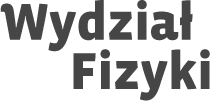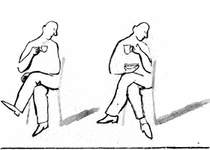- Dla kandydatów
- Dla studentów
- Informacje dla studentów I roku
- Informacje ogólne
- Informator o studiach
- Organizacja roku
- Zarządzenia Prodziekana ds. studenckich
- Kolokwia i egzaminy
- Prace i egzaminy dyplomowe
- Materiały dydaktyczne
- Pracownie
- Pracownia Projektów Studenckich
- Zespołowe projekty studenckie
- Oprogramowanie
- Konta i hasła w sieci studenckiej
- Studia doktoranckie
- Studia podyplomowe
- Samorząd, koła, kluby, chór
- Stypendia i sprawy socjalne
- Oferty pracy
- Dla pracowników
- Dla gości
- Badania
- Rada Naukowa Dyscypliny Nauki Fizyczne
- Kierunki badań
- Priorytetowy Obszar Badawczy II IDUB
- Realizowane projekty
- Sekcja ds. Obsługi Badań
- Seminaria i konwersatoria
- Konwersatorium im.J.Pniewskiego i L.Infelda
- Algebry operatorów i ich zastosowania w fizyce
- Środowiskowe Seminarium Fizyki Atmosfery
- Seminarium Zakładu Biofizyki
- Seminarium z fizyki biologicznej i bioinformatyki
- Seminarium Fizyki Ciała Stałego
- Multimedialne seminarium z ekono- i socjofizyki
- Exact Results in Quantum Theory
- Środowiskowe Seminarium Fotoniczne
- Seminarium Fotoniki
- Seminarium Zakładu Fotoniki
Seminarium Gamma
- Seminarium "High Energy, Cosmology and Astro-particle physics (HECA)"
- Środowiskowe Seminarium z Informacji i Technologii Kwantowych
- Seminarium Fizyki Jądra Atomowego
- Seminarium fizyki litosfery i planetologii
- Seminarium Fizyki Materii Skondensowanej
- Seminarium "Modeling of Complex Systems"
- Seminarium nauk o widzeniu
- Seminarium "Nieliniowość i Geometria"
- Seminarium Optyczne
- Soft Matter and Complex Systems Seminar
- String Theory Journal Club
- Seminarium Koła Struktur Matematycznych Fizyki
- Seminarium "Teoria cząstek elementarnych i kosmologia"
- Seminarium KMMF "Teoria Dwoistości"
- Seminarium Teorii Względności i Grawitacji
- Seminarium "The Trans-Carpathian Seminar on Geometry & Physics"
- Seminarium Fizyki Wielkich Energii
- Konferencje
- Publikacje
- Research Highlights
- Optyka na Uniwersytecie Warszawskim
- Wydział
- Misja i strategia
- Władze Wydziału
- Zarządzenia Dziekana
- Zarządzenia Prodziekana ds. studenckich
- Struktura organizacyjna
- Historia Wydziału
- 90 lat Wydziału Fizyki
- 100 lat Wydziału Fizyki
- Fizykoteka – Wirtualne Muzeum Wydziału Fizyki UW
- Dziekanat
- Rada Wydziału
- Jakość kształcenia
- Stopnie i tytuły naukowe
- Nagrody Wydziału Fizyki
- Biblioteka
- Ośrodek Komputerowy
- Pracownicy i doktoranci
- Zamówienia publiczne
- Rezerwacja i wynajem sal
- Oferty pracy
- Osoby
- Zapraszamy
- Media
2025-06-05 (Czwartek)
Jakub Vašíček (Silesian University in Opava)
Conservation laws and nonexistence of local Hamiltonian structures for generalized Infeld—Rowlands equation
We exhaustively characterize all cases when a certain natural generalization of the Infeld–Rowlands equation admits nontrivial local conservation laws of any order, and give explicit form of these conservation laws modulo trivial ones. The original Infeld–Rowlands equation arises inter alia in the study of solution stability for the Ginzburg–Landau equation. What is more, one of the special cases of our generalization can be seen as an extension of two-dimensional Kuramoto–Sivashinsky equation to dimension three.It turns out that even in the generic case the equation in question, to which we refer to as the generalized Infeld–Rowlands equation, admits an infinite family of local conservation laws parameterized by an arbitrary smooth function of one variable.Furthermore, we prove that the equation under study admits no nontrivial local Hamiltonian structures and no nontrivial local symplectic structures no matter the orders of the structures in question; the method of establishing the said nonexistence results can be readily applied to many other PDEs.For further details please see the article J. Vašíček, Conservation laws and nonexistence of local Hamiltonian structures for generalized Infeld—Rowlands equation, Rep. Math. Phys. 93 (2024), no. 3, 287-300, https://doi.org/10.1016/S0034-4877(24)00038-7.
2025-05-29 (Czwartek)
Ian Anderson (Utah State University)
Superposition Formulas for Differential Systems II
2025-05-22 (Czwartek)
Piergiulio Tempesta (Universidad Complutense de Madrid)
To be announced
2025-05-15 (Czwartek)
Ian Anderson (Utah State University)
Superposition Formulas for Differential Systems I
In these two seminar talks I will survey the Lie group theoretic approach to the classical integration method of Darboux -- based on the symmetry reduction of pairs of differential systems admitting a common symmetry group. Topics include:Differential Equations via Differential SystemsFundamental ConstructionsSymmetry Reduction of Differential Systems.Lie EquationsSymbolic ToolsExamplesDarboux Integrable (DI) SystemsThe Equivalence Problem for DI Systems ClassificationsFurther ApplicationsReferences The book by O. Stomark, Lie's Structural Approach to PDE Systems is a good introduction to the classical literature. Here are references to my work on superposition principles with Mark Fels, Peter Vassiliou, and Brandon Ashley. Exterior Differential Systems with Symmetry Acta. Appl. Math., 87 (2005) 3-31. Superposition Formulas for Darboux Integrable Exterior Differential Systems, Advances in Math., 221 (2009) 1910--1963Transformations of Darboux Integrable Equations,} Proceeding of the 2008 Abel Conference, Tromso, Norway. Springer.Backlund transformations for Darboux integrable differential systems} Selecta Math. New Series 21 (2014) 379-448.Backlund transformations for Darboux integrable differential systems: Examples and Applications Journal of Geometry and Physics 102 (2016) 1-31The Cauchy Problem for Darboux Integrable Systems and Non Linear d’Alembert Formulas, SIGMA 9 (2017) Darboux Integrable f-Gordon Equations and Rank 2 Distributions in Five Variables (in preparation)
2025-05-08 (Czwartek)
Michalina Boczyńska (KMMF)
Symplectic orbifolds and applications (Seminar cancelled due to a day of mourning in the UW)
2025-04-24 (Czwartek)
Artur Sergyeyev (Silesian University in Opava)
To be announced
2025-04-10 (Czwartek)
Julia Lange (University of Warsaw)
Reduction of twisted Poisson manifolds and applications to Hamilton-Jacobi equations
2025-04-03 (Czwartek)
Henrique Bursztyn (Instituto Nacional de Matematica Pura e Aplicada, Brazil)
To be announced
2025-03-27 (Czwartek)
Vera Vertesi (University of Vienna)
A Gentle Introduction to Open Book Decompositions
Open book decompositions provide a combinatorial way to describe and understand contact structures on 3-manifolds. Originally introduced by Thurston and Winkelnkemper, they became a cornerstone of modern 3-dimensional contact topology through the work of Giroux, who observed that contact structures up to isotopy are in one-to-one correspondence with open books up to positive stabilization. The power of this correspondence lies in the fact that an open book is determined by a mapping class group element of a surface with boundary. Since mapping class group elements can be described in terms of Dehn twists along simple closed curves, this correspondence translates problems in contact topology into a combinatorial framework involving curves on surfaces. This approach not only enables concrete computations with specific contact structures but also provides a powerful tool for proving structural results.In this talk, I will introduce the basics of contact structures, explain the role of open book decompositions, and illustrate their connection to contact geometry with hands-on examples.
2025-03-20 (Czwartek)
Roberto Rubio (Universitat Autònoma de Barcelona)
On higher Dirac structures
Dirac structures are the least common multiple of (pre)symplectic and Poisson structures. What about an analogous concept for multi(pre)symplectic and higher Poisson structures? The answer should clearly bear the name of higher Dirac, but we will see that its definition is not so straightforward as one could expect. By always keeping in mind the analogy with standard Dirac structures, we will define, geometrically describe and integrate higher Dirac structures. This is joint work with H. Bursztyn and N. Martínez-Alba.
2025-03-13 (Czwartek)
Javier de Lucas (KMMF, University of Warsaw)
A gentle introduction to Dirac structues
2025-03-06 (Czwartek)
Jorge A. Jover Galtier (University of Zaragoza)
Analysis of a dynamical system: stability, chaos and synchronization of coupled Brusselators
Dynamical systems are sets of differential equations that govern the evolution of parameters of mathematical models with respect to time. Dynamical systems appear in a large number of fields, such as Physics, Chemistry, Biology, Engeneering, etc. The analysis of dynamical systems can be done, in some cases, by direct integration of the equation of the model. This, however, is not possible in general. Instead, qualitative analysis may provide useful information about the system, such as equilibrium points, limit cycles, chaotic behavior, etc.In this talk, I will present a brief introduction to the theory of dynamical systems, as well as its application to a particular example. The Brusselator is a 2-variable model of a cyclic chemical reaction with interesting properties from the point of view of dynamical systems. I will present the main properties of the Brusselator system and describe a coupling among two and three Brusselators. This coupling provides the system with a rich variety of properties, such as chaotic behaviour, which my group has studied during the last years [1,2]. Lastly, I will describe how the analysis of coupled Brusselators allows us to study the synchronization properties of the model.[1] F. Drubi et al., "Connecting chaotic regions in the Coupled Brusselator System". Chaos, Solitons & Fractals 169, 113240 (2023).[2] A. Mayora-Cebollero et al., "Almost synchronization phenomena in the two and three coupled Brusselator systems", Physica D 472, 134457 (2025).
2025-02-27 (Czwartek)
Francisco Caramello (Federal University of Santa Catarina)
Orbifolds: and introduction with applications to foliations
"Manifolds are fantastic spaces. It’s a pity that there aren’t more of them." This quote, by A. Stacey, laconically introduces the broad context of this talk: that the differential geometer disappointingly often finds himself dealing with singularities and outside of his favorite category — the price to pay in exchange for the extraordinarily regular objects it has. Orbifolds, first defined by I. Satake, are among the simplest generalizations of manifolds that try to amend this situation, by relaxing the local models to be quotients of the Euclidean space by a finite group actions, and thus embrace mild singularities. They, as expected, appear naturally in many areas of mathematics when one takes quotients, for instance, as orbit or leaf spaces, and similarly in physics as configuration spaces. In this talk we will briefly introduce them via this classical, local charts approach and illustrate some of their applications to foliation theory.
2024-11-14 (Czwartek)
Ana Balibanu (Louisiana State University)
Reduction along strong Dirac maps
We develop a general procedure for reduction along strong Dirac maps, which are a broad generalization of Poisson moment maps. The reduction level in this setting is a submanifold of the target, and the symmetries are given by the action of a groupoid. When applied to quasi-Poisson moment maps, this framework produces new multiplicative versions of many Poisson varieties that are important to geometric representation theory. This is joint work with Maxence Mayrand. To join use https://uw-edu-pl.zoom.us/j/94548599338?pwd=K1NWTkI3czdqZGNNalZMdWJNNHh1UT09#success
2024-11-07 (Czwartek)
Leonid Ryvkin (University Claude Bernard Lyon I)
Reduction of multisymplectic observables
We develop a reduction scheme for the Lie-infinity-algebra of observables on a pre-multisymplectic manifold M in the presence of a compatible Lie algebra action on M and subset of the manifold M. This reduction relates to the geometric multisymplectic reduction recently proposed by Casey Blacker. In particular, when M is a symplectic manifold and the level set of a momentum our approach generalizes Marsden-Weinstein reduction, and has interesting relations to further symplectic reduction schemes. Based on joint work with Casey Blacker and Antonio Miti. To connect, use the link https://uw-edu-pl.zoom.us/j/94548599338?pwd=K1NWTkI3czdqZGNNalZMdWJNNHh1UT09#success







